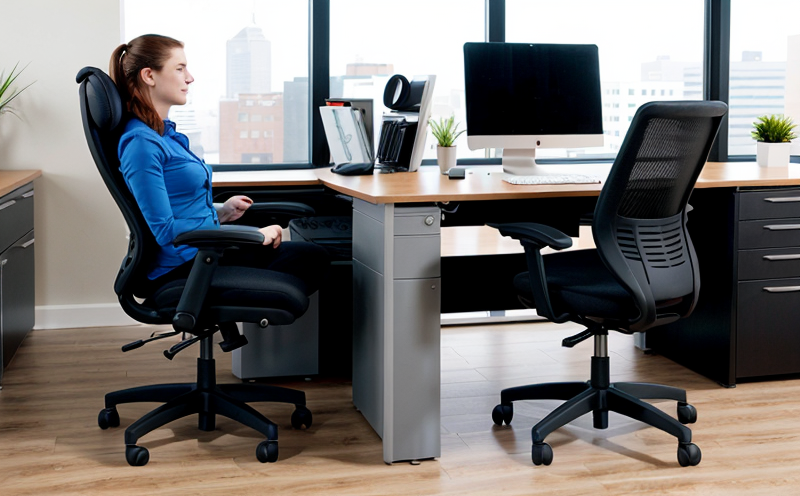ASTM D3574 Physical Properties of Cushion Foams in Office Chairs Testing
ASTM D3574 is a crucial standard that provides methods for determining physical properties of cushion foams used in office chairs. This service ensures that the foam materials meet specific performance and comfort requirements, which are essential for maintaining ergonomic standards and enhancing user satisfaction. The test involves measuring key parameters such as resilience, compression set, and indentation load deflection (ILD). Resilience is a critical factor in determining how well the foam can recover its shape after being compressed. A higher resilience indicates that the foam will maintain its support over time without becoming overly compressed or sagging. Compression set measures the amount of permanent deformation in the foam under sustained pressure, which helps in assessing the longevity and durability of the cushioning material. The indentation load deflection (ILD) is another key parameter used to evaluate the hardness of the foam. ILD is measured by applying a standard weight to the foam sample and recording the depth of penetration. A higher ILD value indicates firmer foam, which can be more suitable for high-activity seating positions like those in office environments. This testing service plays an essential role in ensuring that office furniture manufacturers comply with industry standards and deliver products that meet ergonomic requirements. By adhering to ASTM D3574, manufacturers can ensure that their cushion foams provide optimal support, comfort, and durability, contributing significantly to the overall user experience. The process begins with selecting appropriate samples of foam from various batches or suppliers. These samples are then prepared according to specific guidelines provided in the standard. Once ready, they undergo rigorous testing using specialized equipment designed for ASTM D3574 compliance. The results obtained from these tests provide valuable insights into the physical properties of the foams and help manufacturers make informed decisions about material selection. The importance of this service cannot be overstated, especially given today's increasing focus on workplace ergonomics. Workers spend a significant portion of their day seated at desks, making it imperative that office furniture supports them properly. By ensuring compliance with ASTM D3574 through thorough testing and analysis, we contribute to creating healthier work environments where employees can perform better and stay more comfortable throughout the working hours. In addition to supporting ergonomic standards, this service also helps in maintaining product quality and consistency across different batches or production runs. Consistent physical properties ensure that each piece of office furniture offers similar levels of support and comfort, thereby enhancing customer satisfaction and loyalty.Frequently Asked Questions
What is ASTM D3574?
ASTM D3574 is a standard practice for determining the physical properties of cushion foams used in office chairs. It provides methods to measure key parameters such as resilience, compression set, and indentation load deflection (ILD).
Why is ASTM D3574 important?
ASTM D3574 ensures that cushion foams used in office chairs meet specific performance and comfort requirements. By adhering to this standard, manufacturers can deliver products that support ergonomic standards and enhance user satisfaction.
What are the key parameters measured under ASTM D3574?
The key parameters include resilience (how well the foam recovers its shape after compression), compression set (amount of permanent deformation in the foam under sustained pressure), and indentation load deflection (hardness of the foam, determined by applying a standard weight and recording depth of penetration).
How is ASTM D3574 compliance ensured?
Compliance with ASTM D3574 is ensured through careful sample selection, preparation according to standard guidelines, and rigorous testing using specialized equipment designed for this purpose. The results of these tests provide valuable insights into the physical properties of the foams.
What are the benefits of ensuring ASTM D3574 compliance?
Benefits include supporting ergonomic standards, maintaining product quality and consistency, enhancing customer satisfaction, and contributing to healthier work environments where employees can perform better and stay more comfortable.
Benefits
- Enhances Ergonomic Standards: Ensuring compliance with ASTM D3574 helps maintain ergonomic standards in office furniture design. Properly designed cushion foams contribute significantly to the comfort and well-being of users, reducing the risk of back pain and other musculoskeletal issues.
- Maintains Product Quality and Consistency: By adhering to ASTM D3574, manufacturers can ensure that their cushion foams consistently meet high-quality standards across different batches or production runs. This consistency leads to more reliable products with uniform performance characteristics.
- Boosts Customer Satisfaction: Comfortable and supportive office furniture enhances user satisfaction by providing an enjoyable working experience. Customers are likely to be more satisfied when they receive products that consistently meet their expectations.
- Promotes Healthy Work Environments: Ergonomically designed cushion foams play a vital role in promoting healthy work environments. They help employees maintain good posture, reducing the likelihood of developing health problems associated with prolonged sitting at desks.





